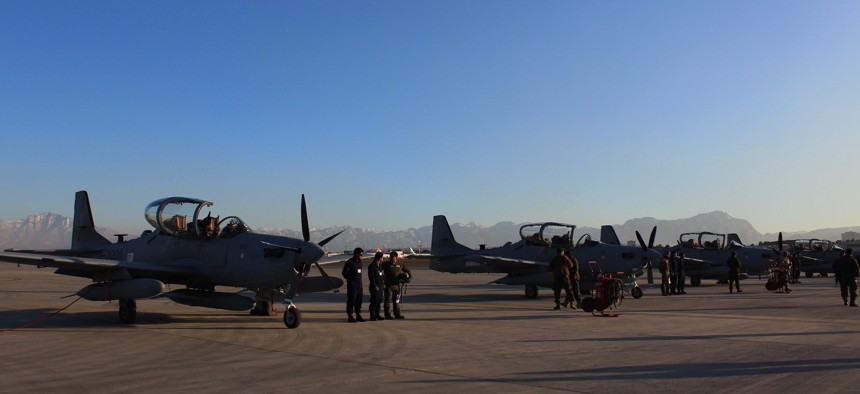
U.S officials formally deliver four Super Tucano attack aircraft to the Afghan Defense Ministry, in Kabul, Afghanistan, on January 15, 2016. Haroon Sabawoon / Anadolu Agency / Getty Images
The Taliban Captured Helicopters. Can They Capture an Air Force?
These are the lethal warplanes that could fall under Taliban control.
Updated at 2:30 p.m. Eastern on Aug. 14.
The Afghan National Security Forces has a long record of losing track of U.S.-supplied guns and rifles. But as the Taliban gains territory following the U.S. troop withdrawal, Afghanistan could lose far more lethal weapons: combat aircraft.
The Pentagon says that has not happened yet, and that the Afghan Air Force continues to fly missions and carry out airstrikes against the Taliban every day. But Taliban fighters, as of Friday, reportedly have captured armored vehicles, small surveillance drones, and several unflyable helicopters. Could they capture more?
“We are always worried about U.S. equipment that could fall into an adversaries’ hands,” Pentagon Press Secretary John Kirby said Friday. “What actions we might take to prevent that or to forestall it, I just simply won't speculate about today.”
As of June 30, the Afghan Air Force had just over 200 aircraft, but only 167 were available for missions, according to the U.S. Special Inspector General for Afghanistan Reconstruction. Most of the planes operate from two bases, one in Kabul and the other in Kandahar. The Taliban on Friday took control of Kandahar, including the airfield.
On Saturday, multiple Twitter postings purported to show Black Hawks and other helicopters that had been operated by the Afghan Air Force seized by the Taliban at the overrun Kandahar Airport, but there was no immediate way to confirm their authenticity.
Many of the aircraft and helicopters are armed, but the most lethal are a small fleet of just over two dozen propeller-driven attack planes. These A-29 Super Tucanos were supplied to Afghan forces specifically so they can provide close-air support to their ground fighters. They can fire laser-guided and other types of bombs.
The Afghan government also has 50 American-made MD-530 attack helicopters, which are armed with machine guns and rockets. Additionally, the Afghan Air Force flies American-made UH-60 Black Hawks and Russian-made Mi-17 helicopters, as well as C-130 and Cessna transports, and a small fleet of armed Cessnas. The U.S. is continuing to provide financial support for many of these aircraft, Kirby said.
“We have made commitments to help [the Afghan Air Force] improve their capabilities,” he said. “Those commitments remain in place.”
Over the last 20 years the U.S. has given the Afghan Air Force more than 130 aircraft. In July, the Defense Department said it was providing the Afghan Air Force more aircraft—including 35 Black Hawks and three A-29 Super Tucanos—in a sign of continued commitment to the Kabul government even as U.S. forces withdrew. Three of the Black Hawks were delivered last month.
The Defense Department was not immediately able to comment on the status of the rest of those new helicopters and attack planes, or whether they would now be held back to keep them from falling into Taliban hands.
The Taliban reportedly captured an Mi-35 helicopter gifted from India, but video showed the aircraft was missing its rotors. The group also posted a video showing two Mi-17 helicopters in a hangar with spare rotors and parts. It also reportedly captured an MD-530, but that aircraft appeared heavily damaged.
Even if the Taliban captures working aircraft, it would be difficult for them to fly it without proper training, according to people familiar with these types of military planes. A trained pilot could fly it, but they would also need to be familiar with the bombs and missiles and know how to mount them and arm the aircraft. And, because the planes need regular maintenance, it’s unlikely the planes would be flyable for long, even by skilled pilots.
Still, to prevent planes from falling into enemy hands, the U.S. could bomb the aircraft or airfields first. Kirby declined to say what actions, if any, the U.S. military would take.
“I'm not going to speculate about … the destruction of property,” Kirby said. “Going forward, we are going to continue to stay focused on making sure they have the capabilities to use in the field.”
Another possibility is that the Taliban could sell the aircraft to Russia and China, who could try to exploit the technology. And even if they’re unflyable, posting pictures and video of the captured aircraft are a powerful propaganda tool for the Taliban.
The majority of these combat aircraft are based in Kabul and Kandahar, according to Military Periscope, an open source military database owned by GovExec, Defense One’s parent company. The Pentagon announced Thursday the U.S. military had sent 3,000 troops into Afghanistanin part to guard the Kabul Airport.
Even before the Taliban began claiming cities and towns, some were sounding the alarm about the U.S. not properly monitoring the weapons it gave Afghan National Security Forces.
In December, the Special Inspector General for Afghanistan Reconstruction said the Pentagon “did not meet enhanced [end use monitoring] requirements to account for all sensitive defense articles transferred to the Afghan government; the requirements are designed to minimize national security risks by preventing the diversion or misuse of defense articles that incorporate sensitive technology.”
Because of the U.S. withdrawal ordered by President Joe Biden, “All aircraft platforms are overtaxed due to increased requests for close air support, intelligence, surveillance, reconnaissance missions, and aerial resupply now that the ANDSF largely lacks U.S. air support,” SIGAR said.
All aircraft are 25 percent over their recommended scheduled-maintenance intervals, SIGAR said. “This is exacerbating supply-chain issues and delaying scheduled maintenance and battle-damage repair.”




